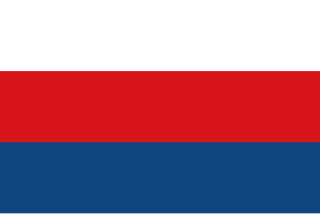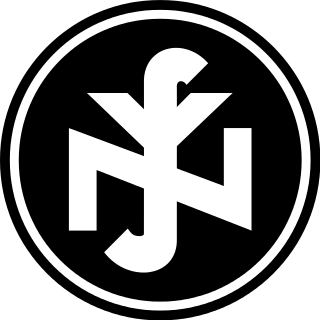
Nazi Germany, officially known as the German Reich until 1943 and Greater German Reich in 1943–45, was the German state between 1933 and 1945, when Adolf Hitler and the Nazi Party controlled the country which they transformed into a dictatorship. Under Hitler's rule, Germany quickly became a totalitarian state where nearly all aspects of life were controlled by the government. The Third Reich, meaning "Third Realm" or "Third Empire", alluded to the Nazis' conceit that Nazi Germany was the successor to the earlier Holy Roman Empire (800–1806) and German Empire (1871–1918). The Third Reich, which Hitler and the Nazis referred to as the Thousand Year Reich, ended in May 1945 after just 12 years, when the Allies defeated Germany, ending World War II in Europe.

The Nazi Party, officially the National Socialist German Workers' Party (NSDAP), was a far-right political party in Germany that was active between 1920 and 1945, that created and supported the ideology of Nazism. Its precursor, the German Workers' Party, existed from 1919 to 1920. The Nazi Party emerged from the German nationalist, racist and populist Freikorps paramilitary culture, which fought against the communist uprisings in post-World War I Germany. The party was created to draw workers away from communism and into völkisch nationalism. Initially, Nazi political strategy focused on anti-big business, anti-bourgeois, and anti-capitalist rhetoric, although this was later downplayed to gain the support of business leaders, and in the 1930s the party's main focus shifted to antisemitic and anti-Marxist themes.

The Sturmabteilung, literally "Storm Detachment", was the Nazi Party's original paramilitary wing. It played a significant role in Adolf Hitler's rise to power in the 1920s and 1930s. Its primary purposes were providing protection for Nazi rallies and assemblies; disrupting the meetings of opposing parties; fighting against the paramilitary units of the opposing parties, especially the Roter Frontkämpferbund of the Communist Party of Germany (KPD) and the Reichsbanner Schwarz-Rot-Gold of the Social Democratic Party of Germany (SPD); and intimidating Romani, trade unionists, and especially Jews such as during the 1933 Nazi boycott of Jewish businesses.

The German concept of Lebensraum comprises policies and practices of settler colonialism which proliferated in Germany from the 1890s to the 1940s. First popularized around 1901, Lebensraum became a geopolitical goal of Imperial Germany in World War I (1914–1918) originally, as the core element of the Septemberprogramm of territorial expansion. The most extreme form of this ideology was supported by the Nazi Party (NSDAP) and Nazi Germany until the end of World War II.

Robert Ley was a German politician during the Nazi era who headed the German Labour Front from 1933 to 1945. He also held many other high positions in the Party, including Gauleiter, Reichsleiter and Reichsorganisationsleiter. He committed suicide while awaiting trial at Nuremberg for war crimes.

Kraft durch Freude was a state-operated leisure organization in Nazi Germany. It was a part of the German Labour Front, the national German labour organization at that time. Set up as a tool to promote the advantages of National Socialism to the people, it had become the world's largest tourism operator by the 1930s.

The German Labour Front was the labour organisation under the National Socialist German Workers' Party which replaced the various independent trade unions in Germany during Adolf Hitler's rise to power.

Organisation Todt (OT) was a civil and military engineering organisation in Nazi Germany from 1933 to 1945, named for its founder, Fritz Todt, an engineer and senior Nazi. The organization was responsible for a huge range of engineering projects both in Nazi Germany and in occupied territories from France to the Soviet Union during World War II. It became notorious for using forced labour. From 1943 until 1945 during the late phase of the Third Reich, OT administered all constructions of concentration camps to supply forced labor to industry.

The Heim ins Reich was a foreign policy pursued by Adolf Hitler during World War II, beginning in 1938. The aim of Hitler's initiative was to convince all Volksdeutsche who were living outside Nazi Germany that they should strive to bring these regions "home" into Greater Germany, but also relocate from territories that were not under German control, following the conquest of Poland in accordance with the Nazi-Soviet pact. The Heim ins Reich manifesto targeted areas ceded in Versailles to the newly reborn nation of Poland, various lands of immigration as well as other areas that were inhabited by significant German populations such as the Sudetenland, Danzig (now Gdansk}, and the southeastern and northeastern regions of Europe after 6 October 1939.

Following the Invasion of Poland at the beginning of World War II, nearly a quarter of the entire territory of the Second Polish Republic was annexed by Nazi Germany and placed directly under the German civil administration. The rest of Nazi occupied Poland was renamed as the General Government district. The annexation was part of the "fourth partition of Poland" by Nazi Germany and the Soviet Union, outlined months before the invasion, in the Molotov–Ribbentrop Pact.

Artur Axmann was the German Nazi national leader (Reichsjugendführer) of the Hitler Youth (Hitlerjugend) from 1940 to the war's end in 1945. He was the last living Nazi with a rank equivalent to Reichsführer.

The Protectorate of Bohemia and Moravia was a partially annexed territory of Nazi Germany established on 16 March 1939 following the German occupation of the Czech lands on 15 March 1939. Earlier, following the Munich Agreement of September 1938, Nazi Germany had incorporated the Czech Sudetenland territory as a Reichsgau.
This is a list of words, terms, concepts and slogans of Nazi Germany used in the historiography covering the Nazi regime. Some words were coined by Adolf Hitler and other Nazi Party members. Other words and concepts were borrowed and appropriated, and other terms were already in use during the Weimar Republic. Finally, some are taken from Germany's cultural tradition.

The Nuremberg Laws were antisemitic and racist laws that were enacted in Nazi Germany on 15 September 1935, at a special meeting of the Reichstag convened during the annual Nuremberg Rally of the Nazi Party. The two laws were the Law for the Protection of German Blood and German Honour, which forbade marriages and extramarital intercourse between Jews and Germans and the employment of German females under 45 in Jewish households, and the Reich Citizenship Law, which declared that only those of German or related blood were eligible to be Reich citizens. The remainder were classed as state subjects without any citizenship rights. A supplementary decree outlining the definition of who was Jewish was passed on 14 November, and the Reich Citizenship Law officially came into force on that date. The laws were expanded on 26 November 1935 to include Romani and Black people. This supplementary decree defined Romanis as "enemies of the race-based state", the same category as Jews.

Holocaust victims were people who were targeted by the government of Nazi Germany for various discriminatory practices due to their ethnicity, religion, political beliefs, or sexual orientation. These institutionalized practices came to be called The Holocaust, and they began with legalized social discrimination against specific groups, and involuntary hospitalization, euthanasia, and forced sterilization of those considered physically or mentally unfit for society. These practices escalated during World War II to include non-judicial incarceration, confiscation of property, forced labor, sexual slavery, medical experimentation, and death through overwork, undernourishment, and execution through a variety of methods, with the genocide of different groups as the primary goal.

The use of slave and forced labour in Nazi Germany and throughout German-occupied Europe during World War II took place on an unprecedented scale. It was a vital part of the German economic exploitation of conquered territories. It also contributed to the mass extermination of populations in occupied Europe. The Germans abducted approximately 12 million people from almost twenty European countries; about two thirds came from Central Europe and Eastern Europe. Many workers died as a result of their living conditions – extreme mistreatment, severe malnutrition, and worse tortures were the main causes of death. Many more became civilian casualties from enemy (Allied) bombing and shelling of their workplaces throughout the war. At its peak the forced labourers constituted 20% of the German work force. Counting deaths and turnover, about 15 million men and women were forced labourers at one point during the war.

The National Socialist People's Welfare was a social welfare organization during the Third Reich. The NSV was established in 1931 as a local welfare organization; on 3 May 1933, shortly after the Nazi Party took power in Weimar Germany, Hitler turned it into a party organization of the NSDAP. The main offices were in Berlin. The structure of the NSV was based on the Nazi Party model, with local, county (Kreis) and district (Gau) administrations.

The 50th birthday of Adolf Hitler on 20 April 1939 was celebrated as a national holiday throughout Nazi Germany and some other parts of the world.
National Socialism, commonly known in English as Nazism, is the ideology and practices associated with the Nazi Party—officially the National Socialist German Workers' Party —in Nazi Germany, and of other far-right groups with similar ideas and aims. Nazism is a form of fascism, with disdain for liberal democracy and the parliamentary system. It incorporates fervent antisemitism, anti-communism, scientific racism, and the use of eugenics into its creed. Its extreme nationalism originated in pan-Germanism and the ethno-nationalist Völkisch movement which had been a prominent aspect of German nationalism since the late 19th century, and it was strongly influenced by the Freikorps paramilitary groups that emerged after Germany's defeat in World War I, from which came the party's underlying "cult of violence". Nazism subscribed to pseudo-scientific theories of a racial hierarchy and social Darwinism, identifying the Germans as a part of what the Nazis regarded as an Aryan or Nordic master race. It aimed to overcome social divisions and create a German homogeneous society based on racial purity which represented a people's community. The Nazis aimed to unite all Germans living in historically German territory, as well as gain additional lands for German expansion under the doctrine of Lebensraum and exclude those who they deemed either Community Aliens or "inferior" races.

Adolf Hitler Schools (AHS) were 12 elite boarding schools run by the SS in Nazi Germany from 1937 to 1945. Their aim was to indoctrinate young people into the ideologies of the Nazi Party. They were for young people aged 14 to 18 years old and were single sex, with three schools for girls and the rest for boys. Selection for admission to the schools was rigorous; pupils were chosen for their political dedication and physical fitness, as opposed to their academic prowess. Activities focused on political indoctrination rather than academic studies. The SS often selected future officers from the schools.


















